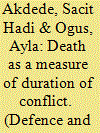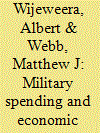| Srl | Item |
| 1 |
ID:
092938


|
|
|
|
|
| Publication |
2009.
|
| Summary/Abstract |
This paper introduces a new measure of conflict duration and argues that the number of deaths in a conflict can serve as such a measure. The paper demonstrates that there are information gains to this approach. The well-known conflict database of the International Peace Research Institute is compared with the database of the Center for Systemic Peace, which includes data on the number of deaths in addition to length of conflict. The number and distribution of conflicts vary; however, duration analysis based on the conventional measure of duration yields results that are robust over the above-mentioned datasets. We also show that the number of deaths, as a measure of duration, challenges some of the results based on the number of years as a measure of duration. In the 1990s, the duration of conflicts is significantly different from before when the duration measure is the number of years - we do not find a statistically significant distinction when the number of deaths is used. Ethnic conflicts have a longer survival time in terms of time but not in terms of number of fatalities.
|
|
|
|
|
|
|
|
|
|
|
|
|
|
|
|
| 2 |
ID:
092937


|
|
|
|
|
| Publication |
2009.
|
| Summary/Abstract |
Transnational terrorism data are difficult to forecast because they contain an unknown number of structural breaks of unknown functional form. The rise of religious fundamentalism, the demise of the Soviet Union, and the rise of al Qaeda have changed the nature of transnational terrorism. 'Old School' forecasting methods simply smooth or difference the data. 'New School' methods use estimated break dates to control for regime shifts when forecasting. We compare the various forecasting methods using a Monte Carlo study with data containing different types of breaks. The study's results are used to forecast various types of transnational terrorist incidents.
|
|
|
|
|
|
|
|
|
|
|
|
|
|
|
|
| 3 |
ID:
092941


|
|
|
|
|
| Publication |
2009.
|
| Summary/Abstract |
In this paper, we employ a VAR analysis to examine the nexus between military spending and economic growth in Sri Lanka which, due to the civil war there, has witnessed a significant increase in military spending over the last three decades while also recording healthy economic growth. The study finds that, compared with non-military spending, military spending exerts only a minimal positive impact on real GDP. Over a 10-year period, a 1% increase in non-military spending increases GDP by 1.6%. In contrast, military spending only increases GDP by 0.05%, suggesting that the economic benefits for Sri Lanka from a sustained peace may be considerable.
|
|
|
|
|
|
|
|
|
|
|
|
|
|
|
|
| 4 |
ID:
092942


|
|
|
|
|
| Publication |
2009.
|
| Summary/Abstract |
Frey and Rohner (2007) propose that governments credibly commit to reconstruction of cultural monuments, as this would deter terrorist attacks on monuments. We contend that precommitment will serve primarily to redirect terrorist attacks toward non-replicable targets, possibly leading to loss of human life and physical capital at the expense of protecting monuments. The cost savings from lowering onsite security are minimal, thus funds would need to be redirected from other governmental activities to protect monuments.
|
|
|
|
|
|
|
|
|
|
|
|
|
|
|
|
| 5 |
ID:
092943


|
|
|
|
|
| Publication |
2009.
|
| Summary/Abstract |
An effective intervention against terrorism - in our case the rapid reconstruction of iconic monuments attacked - induces terrorists to substitute other activities for attacks on cultural icons.
|
|
|
|
|
|
|
|
|
|
|
|
|
|
|
|
| 6 |
ID:
092939


|
|
|
|
|
| Publication |
2009.
|
| Summary/Abstract |
Using a time series method called 'transfer function', this paper examines the effect of terrorism on tourism in Turkey. The results indicate that there exists a negative but small impact of terrorism, which is observed within approximately one year. However, terrorist attacks in Turkey have accounted for a reduction of six million foreign tourists over the last nine years. Moreover, the economic cost of terrorism in the tourism industry was more than $700 million in 2006. However, terrorist attacks in continental Europe and America, and an active war involving a neighboring country, had no effects on tourism in Turkey.
|
|
|
|
|
|
|
|
|
|
|
|
|
|
|
|